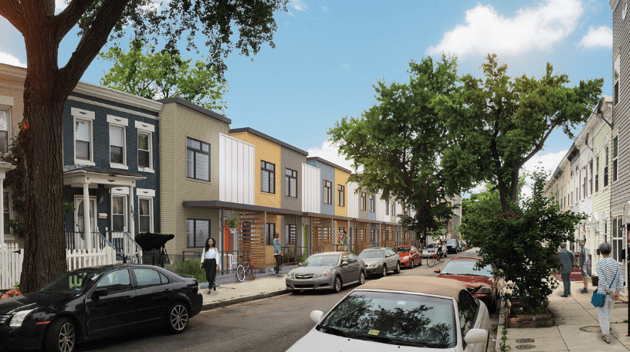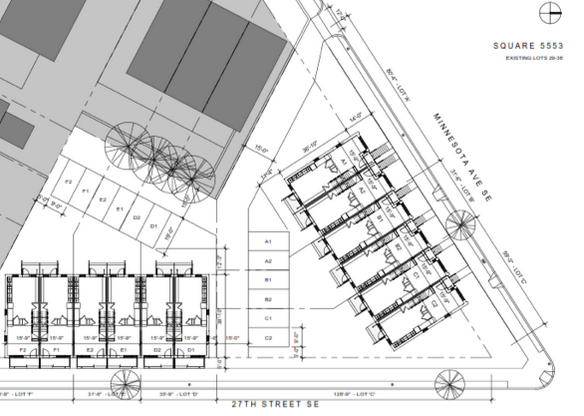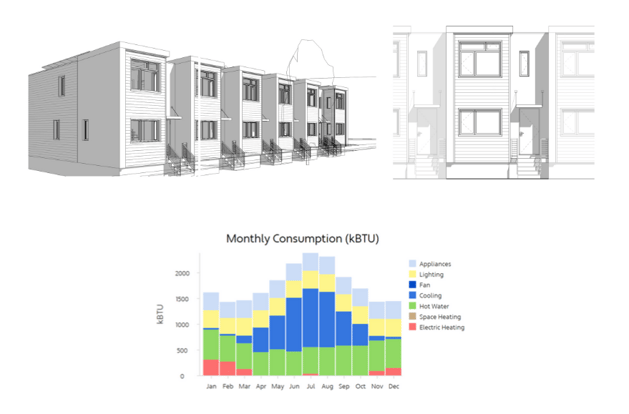
The eCasa housing project was designed to deliver a series of net-zero, affordable housing prototypes in Washington, D.C., for low-income families. Using Sefaira, nonprofit architecture firm Inscape Publico balanced building envelope performance and renewable energy generation in the late design stage to achieve net-zero.
Mi Casa Inc., a nonprofit organization, provides affordable housing opportunities to low and moderate-income families to sustain diverse and healthy communities in the Washington D.C. and Baltimore areas. To address the complex changes impacting neighborhoods in the greater D.C. area and ensure scalability, Mi Casa collaborated with the Department of Housing and Community Development.
Project type: Affordable housing for low-income families
Location: Washington D.C., USA
Building program: Residential
Floor area/stories /occupancy: 2 x blocks of 6 housing units
Performance goal: Net-zero energy
Navigating project limitations
Inscape Publico had designed and specified the building blocks but wanted to understand their performance and optimize the project where possible. The project needed to juggle a limited budget, a limited palette of building materials, and a tight project timeline. Using Sefaira analysis enabled the team to optimize the changeable factors within the project and demonstrate that the project was on track to achieve net-zero energy.
 Site plan showing the location of both blocks on adjacent streets.
Site plan showing the location of both blocks on adjacent streets.
To achieve their goals, the design team needed to:
- calculate the baseline building performance based on specified building materials.
- minimize energy consumption to achieve net-zero by utilizing high-performance construction and specifying high-efficiency appliances and systems.
- calculate how much renewable energy would be generated by pre-specified solar photovoltaic panels to confirm the quantity required to achieve net-zero.
- minimize annual operating costs for the inhabitants by specifying highly efficient water fixtures.
To get started, the design team set up the analysis model, inputting pre-determined envelope and HVAC values and baseline variables such as occupancy, lighting power density, plug load, temperature set points, and diversity factors. Next, potential strategies were investigated:
Shading type and depth: Using Sefaira’s response curves, an optimum 2.5 ft deep horizontal projection was specified over each glazed opening. This reduced annual space cooling by 14%.
Water fixtures: To reduce waste and operating costs, high-efficiency water fixtures were specified.
"Annual operating costs were reduced by 37% because less energy was required to heat water and water usage was much less overall."

Minnesota Street Housing Unit and its corresponding Monthly Energy Consumption Graph
By specifying high-performance values for shading and water fixtures, the design team ensured that the final annual energy consumption figure would be as low as 21,372 kBTU/year for Minnesota Street and 21,073 kBTU/year for 27th Street.

27th Street Housing Unit and its corresponding Monthly Energy Consumption Graph
Having optimized the building envelope for performance, the next step was to offset the energy consumed by generating as much or more energy on-site. Sefaira analysis confirmed that two arrays of 18 photovoltaic panels per block would generate 21,473 kBTU/year for Minnesota Street and 22,025 kBTU/year for 27th Street, thereby ensuring the project would achieve net-zero energy status.
“I would use Sefaira at an even earlier stage to optimize the envelope instead of simply analyzing the materials and details we had already established," said Stefan Schwarzkopf, Design Director at Inscape Publico."
For example, the predetermined roof assembly R-value was quite high; however, Sefaira showed that a roof assembly with a lower R-value performed just as well. Knowing this information earlier on could have enabled the team to make more cost-effective building material and detailing choices.
-01.jpg?width=446&name=Blog-Netzero_1-1%20(Facebook%2c%20Instagram)-01.jpg)
Sefaira enabled the Inscape Publico and Mi Casa team to calculate the annual energy consumption, investigate energy-saving strategies, and apply renewable energy generation, helping the project reach net-zero energy status.
"Sefaira takes the guesswork out of the process of evaluating various design choices to find the ones with optimal impact, helping the design team to fluidly refine not only the project design itself but also the project goals," Schwarzkopf concluded."


